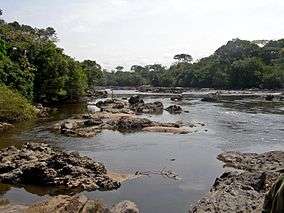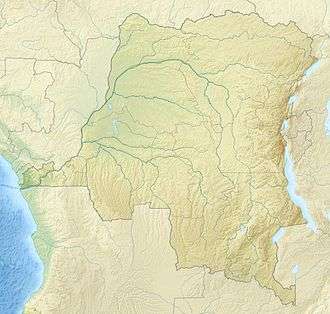Okapi Wildlife Reserve
| Okapi Wildlife Reserve | |
|---|---|
|
IUCN category II (national park) | |
 Epulu River in the Okapi Wildlife Reserve | |
 | |
| Location | Democratic Republic of the Congo |
| Nearest city | Isiro |
| Coordinates | 02°00′00″N 28°30′00″E / 2.00000°N 28.50000°ECoordinates: 02°00′00″N 28°30′00″E / 2.00000°N 28.50000°E |
| Area | 13,726.25 km2 (5,299.73 sq mi)[1] |
| Established | 1992[2] |
| Governing body | l'Institut Congolais pour la Conservation de la Nature (ICCN) |
| UNESCO World Heritage site | |
| Criteria | Natural: x |
| Reference | 718 |
| Inscription | 1996 (20th Session) |
| Endangered | 1997 - |
The Okapi Wildlife Reserve is a World Heritage Site[3] in the Ituri Forest in the north-east of the Democratic Republic of the Congo, near the borders with South Sudan and Uganda. At approximately 14,000 km², it covers approximately one-fifth of the area of the forest.
Location
The Nepoko, Ituri, and Epulu rivers flow through the reserve. The imposing Mbiya Mountain overlooks the Epulu village. The reserve is home to about 5,000 okapis, 4,000 elephants, 2,000 leopards, chimpanzees, and crocodiles. Other Ituri rain forest animals include forest buffalo and water chevrotain. The reserve has over 300 species of bird, and is one of the most important sites for bird conservation in mainland Africa.[4] Nomadic Mbuti pygmies and indigenous Bantu farmers also live within the reserve.
History
The Okapi Wildlife Reserve was created with the help of the Okapi Conservation Project in 1992. The project continues to support the reserve by training and equipping wildlife guards and by providing assistance to improve the lives of neighboring communities.[5] The Okapi Wildlife Reserve was added to the list of World Heritage Sites in danger in 1997. The main threats to the reserve are deforestation, primarily caused by slash and burn agriculture, and commercial hunting for the sale of bush meat. Gold mining has also been problematic to the Reserve. As of 2005, the fighting in the eastern part of the country moved within the boundaries of the Reserve, causing its staff to flee or be evacuated. While the native Mbuti and Bantu peoples traditionally respect the forest and its wildlife, immigrants into the area do not feel the same connection to the land. Lack of funding due to the poor political and economic conditions of the Democratic Republic of the Congo has also been problematic. It is hoped that eco-tourism to the area can be developed, leading to both increased funding and improved public awareness.
Conservation
As its name implies, the Okapi Wildlife Reserve is home to many okapis. As of 1996, the number was estimated at about 3900–6350, out of a global population of around 10,000–20,000. It is also the location of the Epulu Conservation and Research Center, on the Epulu River. This facility dates back to 1928 when the camp was founded by American anthropologist Patrick Putnam as a capture station, where wild okapis were captured and sent to American and European zoos. Until 2012 it still served that function, albeit with very different methodology, as the okapis remained in Congo. In 2012 a rebel attack left the center's captive okapis dead and it was decided to focus exclusively (at least as long as there were security concerns) on preserving the wild okapis in the reserve.[6] The center also carries out much important research and conservation work.
Rebel attacks
On 24 June 2012, the Epulu Conservation and Research Center was attacked, looted and burned by a group of Mai-Mai rebels, lead by Paul Sadala (alias Morgan) and consisting of elephant poachers and illegal miners.[6][7] During the attack, 13 of the 14 okapis at the center were killed (the last died later of injuries sustained during the attack) and six people, including two wildlife rangers, were also killed.[7] Many other locals, some minors, were abducted, but all were released later.[6] In early August, the security situation had improved due to Congolese army troops and guards from the Congolese Wildlife Authority, and preparations for repairs of the center had begun.[8] Following donations from around the world, it had been rebuilt a year after the attack.[6]
On 14 July 2017, there was an attack in the section of the reserve near Mambasa, likely by Mai-Mai rebels. Foreign journalists (two British and an American) and several local park rangers escaped unharmed, but five local reserve employees (four wardens and a tracker) were killed.[9][10] Several of the attackers were also killed.[10]
See also
References
- ↑ INSTITUT CONGOLAIS POUR LA CONSERVATION DE LA NATURE. Okapi Archived 2005-01-18 at the Wayback Machine.
- ↑ Okapi Archived 1997-07-10 at the Wayback Machine.
- ↑ "21 World Heritage Sites you have probably never heard of". Daily Telegraph.
- ↑ "Okapi Wildlife Reserve". Guide for Africa. Retrieved 2011-10-25.
- ↑ "Okapi Conservation Project". Wildlife Conservation Network.
- 1 2 3 4 Mongobay (9 September 2013).A year after devastating attack, security returns to the Okapi Wildlife Reserve (photos). Retrieved 16 July 2017.
- 1 2 Okapi Conservation Project (28 June 2012).Okapi Conservation Project, Epulu Update – June 28, 2012 Archived September 4, 2012, at the Wayback Machine.. Retrieved 15 September 2012
- ↑ Okapi Conservation Project (4 August 2012).Okapi Conservation Project, Update – August 4, 2012 Archived December 22, 2013, at the Wayback Machine.. Retrieved 15 September 2012
- ↑ New York Times (16 July 2017).U.S. journalist found alive in Congo, 5 others are killed. Retrieved 16 July 2017.
- 1 2 France24 (16 July 2017).Kidnapped US journalist in DR Congo found safe, five wardens killed Archived 2017-07-16 at the Wayback Machine.. Retrieved 16 July 2017.
Further reading
- Susan Lyndaker Lindsey; Mary Neel Green; Cynthia L. Bennett (1999). The Okapi. University of Texas Press. ISBN 0-292-74707-1